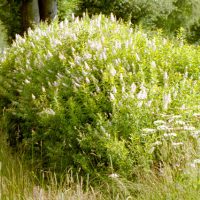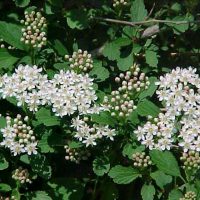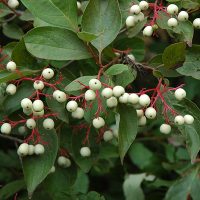Additional information
| Bloom Period | |
|---|---|
| Bloom Color | Green, Yellow |
| Fall Color | |
| Growth Rate | Moderate |
| Height | |
| Spread | |
| Sun | |
| H2O | |
| Tolerates/Resistant To | Juglans, Salt |

$40.00
Rhus copallinum, commonly known as the Winged Sumac or Shining Sumac, is a native plant species found in the state of Illinois, as well as throughout much of the eastern United States. This deciduous shrub belongs to the Anacardiaceae family and is a notable member of the Illinois flora for several compelling reasons:
1. Appearance: Rhus copallinum is a medium-sized shrub, typically growing to heights between 3 to 20 feet (1 to 6 meters). Its distinctive features include pinnately compound leaves with serrated edges, and most notably, the winged branches that give it its common name. These wings, or ridges, run along the stems and are an attractive characteristic, particularly in the winter months when the leaves have fallen.
2. Foliage: The leaves of Rhus copallinum are bright green in the spring and summer, turning vibrant shades of red, orange, or purple in the fall. The compound leaves are divided into multiple leaflets, giving them a feathery appearance.
3. Flowers: In late spring to early summer, Winged Sumac produces small, greenish-yellow flowers arranged in dense clusters called panicles. These flowers are not particularly showy, but they are important for attracting pollinators like bees and butterflies.
4. Fruits: One of the most distinctive features of Rhus copallinum is its clusters of fuzzy, crimson-red berries, known as drupes, that appear in late summer and persist through the fall. These fruits are an essential food source for wildlife, including birds like the Eastern Bluebird and various species of mammals.
5. Ecological Importance: Rhus copallinum plays a crucial role in the Illinois ecosystem as a native plant. It provides food and habitat for numerous species of birds and insects and helps support local biodiversity.
6. Environmental Adaptability: Winged Sumac is well-suited to the Illinois climate, being drought-tolerant and capable of thriving in a variety of soil types, including sandy or rocky soils. It is often found in open woodlands, along roadsides, and in disturbed areas.
7. Cultural and Landscaping Uses: While not typically used in formal landscaping, Rhus copallinum has been utilized for erosion control and as a naturalistic planting in more natural or wildlife-friendly landscapes. Its bright foliage and distinctive berries also make it a visually appealing choice for native plant gardens.
8. Caution: It is important to note that Rhus copallinum is related to poison ivy and poison oak and can cause skin irritation in some individuals. Caution should be exercised when handling this plant, and protective clothing may be advisable.
Rhus copallinum contributes to the state’s ecological diversity, offers beautiful fall foliage, and serves as an essential food source for wildlife. Its unique winged branches make it an interesting addition to the natural landscape and a valuable plant for those looking to support local ecosystems.

Typically found in the wild on wet prairies and open ground along streams and lakes. Does well in medium to wet, well-drained soil in full sun to part shade although it prefers full sun. The cone-shaped white flower clusters bloom in June. May be trimmed to the ground in March and will still bloom on the new wood. Effective for erosion control. Attracts butterflies. Deer resistant.

Very durable large shrub. Features pink or white, five-petaled flowers in late spring. Flowers give way to drooping clusters of reddish fruit. Exfoliating bark exposes cinnamon brown inner bark for winter interest. Great in shrub borders. Full to half-day sun; dry to medium moisture. Attractive to waterfowl and bees.

A tough shrub that is sun and shade tolerant, grows in wet or dry soils, and grows in a variety of soil types. It has white flowers in May that turn to white fruit on red panicles, that birds relish in the fall. Will spread to form thickets if root suckers are not removed. Fall color is a dusky purplish red. Host for many larval butterfly species. Deer resistant.

Dwarf willow found on moist to dry sites. Dark green foliage, dense branching habit. Showy catkins. Full sun to partial shade. Host plant for the caterpillars of various butterflies. Various birds feed on the buds and catkins of willows and construct their nests in willow thickets.